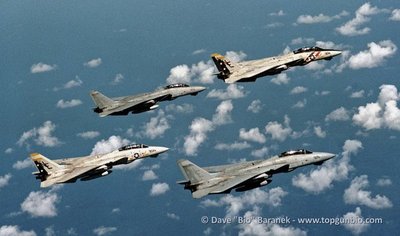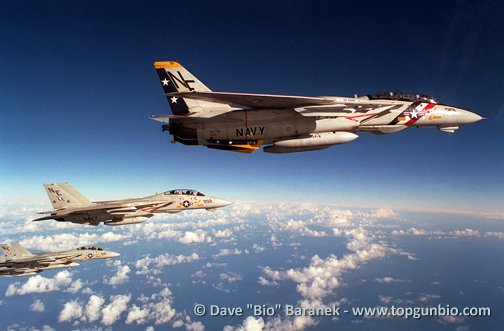FenceCheck Interview: CDR David “Bio” Baranek, USN (Ret.)
Be sure to click on the thumbnails for larger images.
Note: The following was published in November 2008 on Fencecheck.com, a website that was shut down in early 2017 due to persistent hacking. The interview was conducted by André Jans, and in keeping with the focus of the site it addressed the author’s photographic experiences during his career in Naval Aviation. It is presented here with minimal editing from the original, as a tribute to the site. The original had an excellent selection of photos – many of which are also presented here. (In keeping with the focus of the site…get it?)
The mid-1980s were US Naval Aviation’s glory days. Fifteen supercarriers, their decks covered with Grumman “Iron Works” products, Vought A-7s, and brand-new F/A-18 Hornets, held the Soviet Union at bay on the high seas and kept aggression by Libya and Iran in check.
It was also Naval Aviation’s most publicized era. A certain 1986 movie put carrier aviation in the spotlight, but so did photographic coverage of the Navy in action. In particular, several F-14 Tomcat pilots and RIOs were also photography enthusiasts who took cameras in the cockpit with them. Not only did their images offer an unprecedented, insider view of Naval Aviation, but they also helped aviation photography evolve from “portraiture of airplanes” into the dynamic imagery we enjoy today.
Fence Check was fortunate to have one of those F-14 crewmen-cum-photographers, CDR Dave Baranek, talk to us about his experiences and his photography.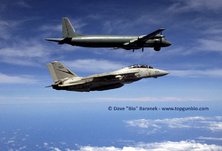
-
Fence Check (FC): Could you please give us a “Bio”-graphy of your career in the US Navy? Where did the call sign “Bio” come from?
I entered the Navy through ROTC, graduating from Georgia Tech in 1979. I knew I wanted to fly fighters from the time I was about 13 years old, and ROTC was the path that worked for me. I went to Naval Flight Officer training in Pensacola a few weeks after college ended.
After Pensacola, I went to Miramar for F-14 Radar Intercept Officer training at VF-124, then joined the Fighting Renegades of VF-24 in April 1981. I made two deployments to the North Arabian Sea and flew with a bunch of great guys – many of them have become lifelong friends. I had 1,260 F-14 hours when I left VF-24.
I went through Topgun as a student while in VF-24, then went back as an instructor from 1984 to 1987 and logged 450 F-5F hours. That may not sound like much, but a lot of those hops were 0.9 hours or less! After Topgun I joined the Bounty Hunters of VF-2 and made two more deployments. Again, they were a great bunch.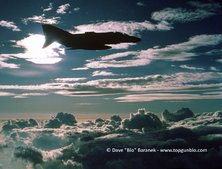
Things got painful from there as I went to the Joint Staff (JCS) in the Pentagon. It was a shock to go from the Fleet to the Pentagon but a great experience. I briefed Secretary of Defense Cheney and Chairman of the Joint Chiefs of Staff General Powell. I then took a year at the Marine Corps Command and Staff College in Quantico before volunteering for US Seventh Fleet, based in Yokosuka, Japan. That was another tough job with some great travel, experiences, and people.
I came back to the Tomcat when I was selected to be XO/CO of VF-211. I went through requalification with VF-101 in Oceana, and joined the Fighting Checkmates in July 1996, just weeks before they moved from Miramar. I became CO in September 1997 and was very proud to lead the squadron through an exciting six-month deployment conducting Operation Southern Watch missions over Iraq with fourteen F-14As. From top to bottom that was a very hard-working group of capable professionals.
My final year in the Navy was on USS George Washington in the Air Department. I retired in 1999.
I met my wife Laura when I was a junior officer in VF-24 and we got married when I was at Topgun. She enjoyed the fighter community and told me many times how lucky I was to have that as my job. I agreed!
As for “Bio,” for a week or so it was “Bionic,” since that rhymes with my last name. LT Steve “Superman” Jones encouraged me to go with that callsign when I was an ensign. But it didn’t sound good on the radio, and I wasn’t very “bionic” anyway, so my first pilot in VF-24 shortened it to Bio. That stuck.
-
FC: What inspired you to take up aviation photography? Did you have any formal photographic training?
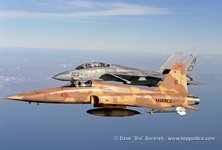 The photography hobby came from my father. Most of his photos were travel shots or family pictures, but he also took some clever, imaginative images. He explained to me how light, cameras, and film worked, and critiqued my earliest shots when I was a teenager. That would be the only “training” I had.
The photography hobby came from my father. Most of his photos were travel shots or family pictures, but he also took some clever, imaginative images. He explained to me how light, cameras, and film worked, and critiqued my earliest shots when I was a teenager. That would be the only “training” I had.
-
FC: It seemed like there were many aircrew photographers in the late ‘80s and early ‘90s, such as yourself, C.J. Heatley, Tom Twomey, Dave Parsons, and others. Was this just a coincidence, or were there special circumstances in that era that led to so many photos by Naval Aviators being published?
It had to be the fact that the F-14 was such an awesome photographic subject!
Thanks, I’m flattered to be included in that group. Heater was senior to me and famous around Miramar when I arrived. But Tumor was a year or two junior. I remember when my younger brother (also a RIO) went to a friend’s party and told me about Tumor’s photos and how great they were. I was glad I was never in the same squadron as him or no one would have seen my shots! I met HeyJoe at a party in Pensacola through a mutual friend and we kept in touch when we progressed to the Fleet on opposite coasts.
But back to the question: maybe you could attribute it to the huge canopy and great visibility of the F-14. Plus it had a lot of room for cameras and lenses.
-
FC: What was the Navy’s position on aircrew flying with cameras? Did special arrangements have to be made in order for you to take photos? Were there restrictions on what you could do with the photos? (E.g.: copyrights, ability to sell your images)
Now you’re asking questions I never asked. An Air Force pilot told me they were not allowed to carry cameras, as a result of a mishap related to a photo shoot. That rule may have only applied to single-seat aircraft; it was around 1984. I never heard of an official Navy policy on aircrew carrying cameras, but several squadrons I was in had SOPs (standard operating procedures) requiring any photo ops to be briefed. That wasn’t a problem, it was good sense. By the way, I’m well aware the Navy had several mishaps related to photo ops, too.
Many times I just took photos of opportunity from within a formation – most of those are sitting in my files and not going anywhere. If I had anything unusual in mind, I would discuss it in the brief, but even then it would be a low priority. There were only a few times when we went out on a currency flight or fam flight and had a lot of time and fuel to spend on photos. I would say that most of my shots were shots of opportunity. In retrospect, I wish I had put more thought into what looked good, but there were only a few times when I had an inspiration and set up the photo.
In terms of using the photos, another aircrew-photographer told me that if I provided a few images to the Navy, I could use the others as I wished. I never saw this in writing, but it led me to give some slides, negatives, and prints to the Miramar photo lab and Navy Chief of Information Office (CHINFO). (Update: Those were available for a time, but access to that website has apparently changed.) When I was at the Pentagon I actually called the Navy Judge Advocate General office and asked about the rules for using photos I took while flying. The guy at the next cubicle told me I was dumb to use my real name. The JAG I talked to didn’t know the answer and never called me back.
When I was at Topgun I met George Hall. He was a great guy and a mentor, in addition to a superb photographer. He looked through all of my shots and used some of them in his agency, books, and calendars. George and his widow Nicky have kindly represented those photos as part of their business, Planepix.
-
FC: What was your preferred camera gear? What films did you use?
Great question. During my first deployment one of the LCDRs let me borrow his Nikon for a few months. I got some great photos with that, and during the deployment I bought a Konica FS-1 because it had an auto-winder in the handgrip. I later bought an FT-1, a 35-105 zoom, and a 24 mm wide-angle lens. When I went back to VF-211, I bought a Nikon F50 with a 35-135 mm lens. I never spent too much money on the equipment.
My film selection was terrible, very shortsighted. I would use print film if I was shooting something I thought the PAO may want to use. For slide film I would buy Ektachrome or Kodachrome at random. A few times I planned ahead, such as when I got some 800 or 1000 ASA film specifically for an evening afterburner shot – which turned out well, and in which I like the grain. I hate to think back about my poor film choices, so let’s move on to the next question.
-
FC: How often were you able to take a camera along on a flight? What equipment would you typically bring?
I took my camera on most flights, unless we launched for a mission involving all night flying. I was only told not to take a camera on a few flights that were classified. (Some of them have since been declassified; do an Internet search for “Constant Peg” to learn more.) I also did not take my camera flying when I went through Topgun as a student or on a few other intense flights.
When I was carrying, I took my camera, maybe an extra lens, and maybe extra film. I either threw them in my helmet bag or used a small padded case. For awhile in VF-2 I also used a small tripod (yes, a tripod) to which I attached a vise grip tool with a couple of zip ties. I used the vise grips to clamp the tripod to a bracket on the back of the pilot’s ejection seat – it was a static bracket, no cables attached! I used this with the 24 mm lens and cable release to get a few decent shots looking back.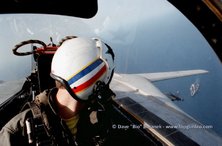
One night in 1983, I took my electronic flash and took some shots of our flight lead in afterburner. We briefed it and I ensured they were ready for the flash. But I wasn’t using the right film; they didn’t turn out very well.
-
FC: Please describe some of the challenges of taking photos from your different mission aircraft. In particular, what were some of the considerations with handling camera equipment (or stowing it!) on ACM missions?
Although I often had the camera with me, for most of a flight it stayed on the side console. Most of the G during maneuvering is positive and a camera stays put at 6.5 G as well as it does at 1 G. It was easy to hold the camera down when we unloaded (negative G). I didn’t carry a camera much for my first few months of flying, and by the time I did I was comfortable in the cockpit and environment. The F-14 had a lot of room, and the F-5’s cockpit was also roomy for a small jet.
I actually have a few photos from ACM engagements. They are from less-dynamic engagements, such as 2v2, where it was possible to have two tallies and a visual, then pick up the camera for a quick shot. They’re not very good shots, though, as we had a 500’ separation bubble for safety and most passes were outside of that distance.
The challenges included reflections and distortions from the canopy. Some pros use a black cloth to reduce reflections. I would hold up my hand on occasion, which didn’t work well and sometimes I couldn’t use shots because of glare I hadn’t noticed. So that black cloth would’ve been a good idea. I found that I could minimize distortion by shooting straight out instead of at an angle.
Another challenge was a scratched or dirty canopy, but our plane captains took a lot of pride in their aircraft and tried to keep the canopies in good shape. I eventually carried canopy wipes (heavy paper towels) and would wipe down the “prime shooting areas” when I manned up for most day flights.
-
FC: Were your pilots and squadron mates accommodating of your photo interests?
The pilots were accommodating. I was careful to get a sense of the flight: how much fuel and time we had and how much we could expend. I would usually tell the pilot that something looked good, and say, “Move up a little. Now forward. This is good, stay here.”
When I was in Topgun we had a slide show at the end of every class, and setting that up was one of my collateral duties. I needed shots of every aircraft going through the class, so the guys I was flying with knew there was a real reason for those photos, not just personal amusement.
Most of my F-14 hours were in the 1980s when the aircraft had only the air-to-air mission. We had less-stringent training requirements than we would later have, and we seemed to have more fuel and time – those two golden resources. So we could spend a little more effort on taking photos. Later, when I was a squadron XO and CO, things were quite different. For one, I did not want to be the commander who was more interested in taking photos than doing the mission. But also, our flights were scheduled tighter. The lieutenants wanted to be up there training according to a syllabus, not wasting time. As a warrior it was great! I still got some photos that I’m really happy with. 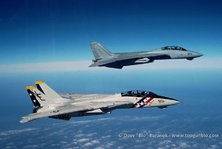
-
FC: Did you aim for special angles, compositions, or effects while shooting?
You had to be careful shooting F-14s, as they looked really “clunky” with the wings out at 20 degrees (full forward sweep) if you shot them wing-on, or from near the wingtip. I personally liked the wings swept back at 50 to 55 degrees; I liked that even better than fully swept to the 68-degree position. Once you had the wings set, shooting from the forward quarter or rear quarter always looked cool, whether you were looking up or down. This was true of the F-14 and the F-5 – the two aircraft with which I have the most experience.
I also preferred shots with more than one aircraft in the frame. It just seemed to add more interest than having a single subject. One of my favorite multi-plane shots is two VF-2 F-14s in “high holding,” orbiting 16,000’ above USS Ranger waiting for our turn to land. Things I like about this shot are the low sun angle (it was about 4 pm), the fact that the jets are carrying weapons, and the clouds. The fact that they have different tail paint schemes was a bonus.
Another shot of VF-2 aircraft shows the difference between the low-visibility paint scheme and the previous standard light gray.
I also like the shot of two VF-211 F-14s, again carrying weapons. This one was shot as they detached to “spin it” in the landing pattern due to timing considerations. It was a split-second photo opportunity. I like this one because the jets are kind of dirty. They look like hard-working fighters.
-
FC: How many photos did you take during a typical flight? During a typical cruise?
That varied widely. I would sometimes go on two or three flights without shooting anything. If I got into a good situation I might shoot three or four shots, or occasionally an entire roll. Man, I wish we had good digital cameras back then....
I shot an entire roll when I shot the full afterburner climb photos of a VF-2 F-14A off Vietnam in 1989 – more about that later. I shot two rolls and some video several months later when flying with a division (four aircraft) of VF-2 Tomcats transiting to a practice strike mission. I was the fifth aircraft so I had all four in the picture, in a diamond formation, with their wings swept. They looked great!
But most of the time, if I saw something I liked I would shoot one photo. Bob Lawson told me what all photographers should know: film is cheap. But I didn’t start shooting a lot until my final flying tour. As a result, I now have less than 200 slides from each of my early deployments. I have another 200 or so from my years in Topgun. This is everything, including useless shots, squadron parties, Wog Day, etc. There are also a few prints, but they haven’t aged as well as the slides.
Don’t get me wrong, I’m happy with many of my photos, but the message to photographers is shoot, shoot, shoot when you get the chance.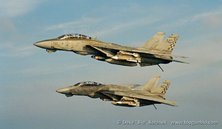
-
FC: Was it possible to develop films on board the ship or did you have to wait for port visits or the end of a cruise to see your results?
We didn’t have commercial photo developing on the ship, and I rarely used the ship’s Photo Lab. The only exceptions were if you shot something of interest to the Navy, such as a patrolling Soviet Bear, or you made arrangements to take some shots for the ship’s PAO. Most of the time I used mail-order developing, usually from Kodak. If a port call was imminent I would save my film and have it developed in a convenient place, whether we were in Singapore, Perth, Dubai, or elsewhere.
-
FC: Earlier we mentioned some of the other aviators/photographers who were active in the same era as you. Did you associate with any of them to exchange information and ideas? How about the photo departments on the ships and bases you were assigned to?
Not as much as I wish I had. As I said, I knew Tumor, HeyJoe, George Hall, and others, but we didn’t talk much about photos or techniques. Several pilots in VF-24 were good photographers: Bob “Preppy” Thompson, Tom “Cowboy” Koelzer, and Paul “Nick” Nickell. We did talk about photography some, and would sometimes put together a tray of slides if we got some good stuff. But we seemed to have different interests and didn’t compare notes or techniques that much.
The photographers’ mates (PH) on the carriers I was on were always a great bunch. I didn’t really “hang out” with them much, but I would visit them and talk about shooting, printing, and their career plans. Several of them wanted to borrow my negatives to practice printing – working with colors and other skills of the trade – which was fine with me. The Miramar Photo Lab in the late 1980s was also a nice group. I have to say I was pleased that so many of my photos made it to the Defense Imagery site. I had wondered if they actually did anything with them. And Mr. Russ Egnor of CHINFO in the Pentagon always seemed very appreciative, which was great.
-
FC: Describe one or two of your most memorable photo shoots.
One of them would have to have been standing in a C-2 with the ramp down, about 8,000’ above the Indian Ocean, shooting the VF-2 F-14A behind us. This was in July 1989 during a deployment with CVW-2 aboard USS Ranger. The F-14 pilot was Dave “Hap” Chandler, and as he stabilized about 20’ behind us, I used hand signals to ask him to climb a little, descend a little, etc. It was so damn cool seeing that jet hang in space just yards from my face.
One of my real favorites, though, was in April 1989 when I shot a VF-2 F-14 in a zone 5 (full afterburner) climb. I wanted to shoot a jet in full burner at twilight. Through experience I realized that higher speed made it more difficult to get a good shot, so I got the idea to pull the nose up to control airspeed. One day I was assigned a section (two aircraft) combat air patrol (CAP) mission that launched just after sunset. My pilot and the other crew were game, so I briefed my plan. We rendezvoused at 10,000’ overhead the ship and pointed toward our station. Then the flight lead, Tom “Pager” Page, swept his wings back to 55 degrees, counted 3, 2, 1, and simultaneously selected burner and pulled his nose up. I was flying with Paul “Lumpy” Akerlund, who simply had to stay in formation.
The sight of Pager rocketing upward was so amazing that several times I looked at it directly instead of through the viewfinder, in awe of the crystal clear shock diamonds in the brilliant blue-white exhaust cones, which stretched fifty feet behind the aircraft! I still managed to shoot 24 frames before I came up on the radio, “Okay, I’m good.” We had climbed to mission altitude of about 25,000’ and had good knots, but we had burned through our mission fuel. That was definitely below-average headwork on my part. Luckily we were never called from our CAP station, where we quietly orbited for the next 90 minutes, “making gas” until we were on our fuel plan by the time we commenced our approach. At least that’s what we told Ranger controllers when we checked in!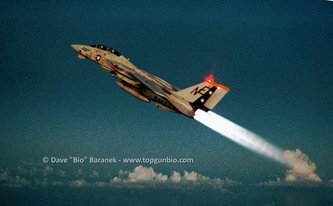
-
FC: How were your photos used while you were on active duty?
Before the Internet, I was happy to see my photos used locally: the base newspaper at Miramar used a few. A bigger deal was being in The Hook magazine, published by the Tailhook Association. I knew they were selective, and editor Bob Lawson became a mentor and friend. Other users included Testors Corporation, who put some of my F-14 and Topgun-related photos on the boxes of models they produced in conjunction with “Top Gun.”
The first book that used my shots was “Tomcats Forever,” by Bob Dorr and David Brown, which was a big thrill. Then in the early 1990s some of my shots made the cut for articles on the F-14 in World Air Power Journal (WAPJ) magazine. WAPJ was a large, glossy production, and once again I was proud to be included.
Over the years I didn’t get much coverage in Navy magazines. Funny, but I was never a public affairs officer, and the squadron PAOs usually sent their own shots in. That was fine with me, there was plenty of recognition to go around. I won a prize in the US Naval Institute’s Proceedings 1985 photo contest with a shot my wife picked out. I eventually got into some Navy publications: a tight shot of a VF-211 F-14 enveloped in steam while being directed to the catapult made it to Naval Aviation News and Navy Times in 1997. And Peter Mersky, another good friend, used a few of my photos in the Navy Safety Center’s Approach magazine in the late ‘90s.
-
FC: How are your photos used and distributed today? Does the Navy still have any rights to them or control over their use? What are your main outlets? Is there still a healthy demand for images of Naval Aviation’s glory years?
The Navy had my shots on the Defense Images site (in 2008), but I don’t get any feedback from them regarding demand. Planepix still has them on file and lets me know once in awhile when they’ve gotten interest in some. I think my greatest exposure is on F-14 web sites such as Tomcat Alley, M.A.T.S., and the F-14 Tomcat Association site. (Update: The photography sales site Stocktrek also sells high quality prints of some of my photos. Here’s the link: http://www.stocktrekimages.com/results.asp?lstfotogs=DBR.)
The book market seems strong, too. I was proud to have some shots in the Parsons, Hall, and Lawson book, “Grumman F-14 Tomcat, Bye Bye Baby.” And I’ve been in contact with several other authors working on F-14 books, so Tomcat fans have more goodies to look forward to.
As a long-time fan of all types of aviation, I am still thrilled to see my photos in these books and recall the great flying that I experienced to get the shots.
-
FC: We understand that you’re writing a book. Can you tell us more about it? Will it include your photos?
Man, you guys don’t miss much! I have completed a manuscript. It’s a memoir of my first few years of flying: from training in Pensacola, through adventures in VF-24, including a split-second ejection, and going through Topgun as a student, to going back to Topgun as an instructor. It’s an adventure tale with a positive tone. Being at Topgun when Paramount filmed the movie was just great; the Hollywood crew that I knew was every bit as professional and committed to excellence as Naval aviators. I recently signed with a literary agent and we’re now working on finding a publisher. Oh, it will have plenty of photos.
I’ve enjoyed going over these topics, recalling my adventures (and a few small mistakes) from years of flying. Thanks to those who will take the time to read this on the FenceCheck site. If and when the book moves forward, I’ll be sure to let you know.
